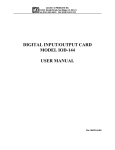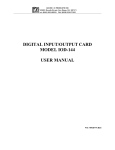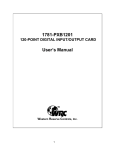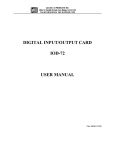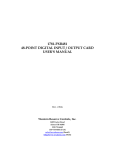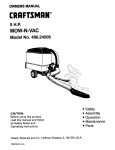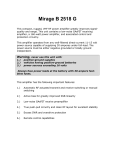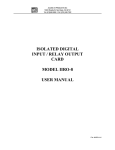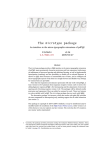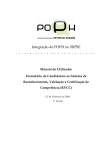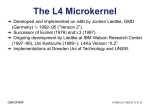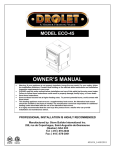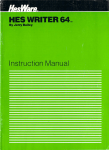Download 1781-PXB721 Discrete I/O Interface User`s Manual
Transcript
1781-PXB721 Discrete I/O Interface User’s Manual Western Reserve Controls, Inc. 1 1781-PXB721 USER'S MANUAL Although every effort has been made to insure the accuracy of this document, all information is subject to change without notice. WRC takes no liability for any errors in this document or for direct, indirect, incidental or consequential damage resulting from the use of this manual. Document PUB 28.0 Rev 1.50 November 2000 Copyright © 1996-2000 WRC Western Reserve Controls, Inc. 1485 Exeter Road Akron OH 44306 330-733-6662 (Phone) 330-733-6663 (FAX) [email protected] (Email) http://www.wrcakron.com (Web) SmartMux, PXB721 and WRC are trademarks of Western Reserve Controls, Inc. IBM PC, PC/XT, and PC/AT are registered trademarks of the International Business Machines Corporation. All other trademarks are property of their respective companies. i 1781-PXB721 USER'S MANUAL TABLE OF CONTENTS 1. INSTALLATION .......................................................................................................................1 2. FUNCTIONAL DESCRIPTION................................................................................................3 3. OPTION SELECTION...............................................................................................................5 4. ADDRESS SELECTION............................................................................................................7 5. SOFTWARE...............................................................................................................................9 6. PROGRAMMING....................................................................................................................12 7. CONNECTOR PIN ASSIGNMENTS .....................................................................................22 8. SPECIFICATIONS ..................................................................................................................23 APPENDIX A PPI DATA ............................................................................................................24 TABLE OF TABLES Table 1 Standard Address Assignments for PC and PC/XT Computers ............................................7 Table 2 Address Set-up Switches.....................................................................................................8 Table 3 Switch Selection Example ....................................................................................................8 Table 4 Address Selection Table ..............................................................................................12 Table 5 I/O Control Register Definitions .........................................................................................13 Table 6 Connector Pin Assignments................................................................................................22 TABLE OF FIGURES Figure 1 1781-PXB721 OPTION SELECTION MAP....................................................................6 ii 1781-PXB721 USER'S MANUAL 1. INSTALLATION BACKING UP THE DISK The software provided with the PXB721 is on a 3.5" floppy. As with any software package, you should make backup copies for everyday use and place your original master diskette in a safe location. The easiest way to make a backup copy is to use the DOS DISKCOPY utility. In a single-drive system the command is: DISKCOPY A: A: In a two-disk system the command is: COPY A:*.* B: This will copy the contents of the master disk in drive A to the backup disk in drive b. HARD DISK USERS The files contained on the master disk may also be copied onto your hard disk. Files contained on the disk are stored in separate directories. These are: FINDBASE: Contains tools to find a working card address. PSAMPLES: Contains Pascal samples and the Pascal-linkable driver. CSAMPLES: Contains "C" samples and the C-linkable driver. BSAMPLES: Contains the BASIC and QuickBASIC samples as well as the binary Q and linkable drivers. VB_WRC: Contains VisualBASIC sample and VisualBasic-linkable driver. To install on a hard disk: 1) Place the master diskette into a floppy drive. 2) Change the active drive to the drive that contains the master diskette. This is usually drive A. 3) Type INSTALL and follow the screen prompt. INSTALLING THE CARD Before installing the card carefully read the ADDRESS SELECTION and OPTION SELECTION Sections of this manual and configure the card according to your requirements. Use the special software programs 1 1781-PXB721 USER'S MANUAL called PXB721ST and FINDBASE provided on diskette with the card. They supply visual aids to configure all areas of the board. Be especially careful with address selection. If the addresses of two installed functions overlap, you will experience unpredictable computer behavior. To install the card: 1. Remove power from the computer. 2. Remove the computer cover. 3. Remove blank I/O backplate. 4. Install jumpers for selected options. See OPTION SELECTION, SECTION 3. 5. Select the base address on the card. See ADDRESS SELECTION, section 4 6. Loosen the nuts on the strain relief bar and swing top end free. 7. Install the card in an I/O expansion slot. If convenient, select a slot which is adjacent to a vacant slot because this will make cable installation easier. 8. Thread the I/O cables, one by one, through the cutout in the mounting bracket and plug them into the headers. 9. Smooth the cables as close as possible to the card and while holding them close to the surface of the card, swing the strain relief bar into position and tighten nuts. 10. Inspect for proper fit of the card and cables and tighten screws. 11. Replace the computer cover. 2 1781-PXB721 USER'S MANUAL 2. FUNCTIONAL DESCRIPTION FEATURES § § § § § § § 72 Channels of Digital Input/Output. All 72 I/O lines Buffered on the Board Four and Eight Bit groups Independently Selectable for I/O. Hysteresis and Pull-Ups on I/O Lines. Interrupt and Interrupt-Disable Capability. +5V Supply Available to the User. Compatible with WRC Industry Standard I/O Racks and other, such as Opto-22, Potter & Brumfield, etc. APPLICATIONS § § § § § § § Automatic Test Systems. Robotics Security Systems, Energy Management. Relay Monitoring and Control. Parallel Data Transfer to PC. Sensing Switch Closure or TTL, DTL, CMOS Logic Driving Indicator Lights or Recorders The 1781-PXB721 Board was designed for industrial applications and can be installed in any I/O slot of an IBM PC/XT/AT or compatible computer. Each I/O line is buffered and capable of sourcing 15 mA or sinking 24 mA (64 mA on request). The card contains three Programmable Peripheral Interface chips type 8255-5 (PPI) to provide computer interface to 72 I/O lines. Each PPI provides three 8-bit ports A, B and C. Each 8-bit port can be software configured to function as either inputs or output latches. Port C can also be configured as four inputs and four output latches. The I/O line buffers (74LS245) are configured automatically by hardware logic for input or output use according to direction assignment from a control register in the PPI. Two I/O lines of each port can be used to interface User Interrupts to the computer. Interrupts are buffered and are enabled by jumper installation or by a combination of jumper installation and a digital input line. You can use Interrupts #2 through #7,#10 through #12,#14, and #15. Interrupts of all ports (one per port) are OR'ed together. I/O wiring connections are via 50-pin headers on the board. Three flat I/O cables connect the 1781-PXB721 to termination panels such as ACCES' model STA-50. Also, this provides compatibility with OPTO-22, Gordos, Potter & Brumfield, etc. module mounting racks. Every second conductor of the flat cables is grounded to minimize the effect of crosstalk between signals. If needed for external circuits, +5 VDC power is available on each I/O connector pin 49. If you use this power, we recommend that you include a 1A fastblow fuse in your circuits in order to avoid possible damage to the host computer in the event of a malfunction in external circuits. The PXB721 occupies sixteen bytes of I/O address space. The base address is selectable via a DIP switch anywhere within the range of 000-3FF hex. If in doubt how to select a base address, check your computer 3 1781-PXB721 USER'S MANUAL Reference Manual. For additional information about setting the base address of 1781-PXB721, see the Address Selection Section of this manual. Utility software provided on diskette with the 1781-PXB721 card is an illustrated setup program. Interactive displays show locations and proper settings of DIP switches and jumpers to set up board address, interrupt levels, and interrupt enable. Also, sample programs in Turbo-C and Turbo-Pascal are presented in Software Section of this manual. In addition a sample program and utility driver are provided for use with VisualBASIC for windows. 1781-PXB721 BLOCK DIAGRAM Typical of three sections 4 1781-PXB721 USER'S MANUAL 3. OPTION SELECTION Refer to the setup programs on the diskette provided with the card. Also, refer to the 1781-PXB721 card BLOCK DIAGRAM on the previous page and the OPTION SELECTION MAP on the following pages when reading this Section of the manual. Board Address selection is covered both by the setup program and by the Address Selection Section of this manual. Interrupts are accepted on the I/O connector pin 9 (port C3). The interrupt signal is positive true. Interrupts are enabled if the IEN jumper is installed or if the IP jumper is installed but the C7 I/O line is high. Interrupts are directed to levels #2 through #7,#10 through #12, #14 and #15 by jumpers installed at locations labeled IRQ2 through IRQ15. The foregoing are the only manual setups necessary to use the 1781-PXB721. Input/Output selection is done via software by writing to a control register in each PPI as described in the PROGRAMMING section of this manual. 5 1781-PXB721 USER'S MANUAL 1 J4 R13 PORT 2 CU21 R12 CU13 U23 IEH2 2 CU22 INP2 R11 CU10 U21 U22 U24 U10 CL U20 B CH U13 1 J3 PORT 1 IEH1 A +5 2 INP1 CU15 R8 CU13 R7 U17 U15 R9 U16 C1 CU16 U12 CU12 B CL U14 CH U13 2 IEH0 1 J2 PORT 0 J1 R4 U42 A +5 R3 INP0 R2 U9 U10 U7 U6 U8 R1 R25 CU1 CU4 CU5 CU11 U1 U5 U2 IMS IRQ2 U26 U3 U11 CU3 IRQ3 IRQ4 IRQ5 IRQ6 IRQ7 U25 CU6 Figure 1 1781-PXB721 OPTION SELECTION MAP 6 A9 A8 A7 A6 A5 A4 1781-PXB721 USER'S MANUAL 4. ADDRESS SELECTION The 1781-PXB721 Input/Output Card occupies 16 bytes of I/O space. The card base address can be selected anywhere within an I/O address range 100-3F0 hex in AT's (except 1F0 to 1F8) and 200-3F0 in XT's. However two installed options cannot share the same address. If in doubt where to assign the base address of the PXB721, refer to the tables below and the FINDBASE program to find an available address in your system. Table 1 Standard Address Assignments for PC and PC/XT Computers Hex Range 000-00F 020-021 040-043 060-063 080-083 0AX 0CX 0EX 100-1FF 200-20F 210-217 220-24F 278-27F 2F0-2F7 2F8-2FF 300-31F 320-32F 378-37F 380-38C** 380-389** 3A0-3A9 3B0-3BF 3C0-3CF 3D0-3DF 3F0-3F7 3F8-3FF Usage DMA Chip 8237A-5 Interrupt 8259A Timer 8253-5 PPI 8255A-5 DMA Page Register NMI Mask Register Reserved Reserved Not Usable Game Control Expansion Slot Reserved Reserved Reserved Asynchronous Communication (secondary) Prototype Card Fixed Disk Printer SDLC Communications Binary Synchronous Comm. (secondary) Binary Synchronous Comm. (primary) IBM Monochrome Display/Printer Reserved Color/Graphics Diskette Asynchronous Communication (primary) ** These options can not be used together - addresses overlap To set desired board addresses, refer to the illustrated Board Address setup program on the Utility diskette provided with the card. Type the desired address in hexadecimal code and graphic display shows you how to set the ADDRESS SETUP switches. These switches are marked A4-A9 and form a binary representation of the address in negative-type logic. (Assign '0' to all ADDRESS SETUP switches turned ON, and assign '1' to all ADDRESS SETUP switches turned OFF.) 7 1781-PXB721 USER'S MANUAL Table 2 Address Set-up Switches Switch Identification Address Line Controlled A9 A9 A8 A8 A7 A7 A6 A6 A5 A5 A4 A4 The following example illustrates switch selection corresponding to hex 2D0 (or binary 10 1101 xxxx). The "xxxx" represents address lines A3, A2, A1, and A0 used on the card to select individual registers at the PPI's. See section 3, PROGRAMMING. Table 3 Switch Selection Example Hex representation Conversion multipliers Binary representation Setup Switch ID. (label) 2+0=2 2 1 OFF A9 1 0 ON A8 8+4+0+1=13=D(hex) 8 4 2 1 1 0 OFF OFF ON A7 A6 A5 1 1 OFF A4 CAUTION Carefully review the address selection reference table on the previous page before selecting the card address. If the addresses of two installed functions overlap you will experience unpredictable computer behavior. 8 1781-PXB721 USER'S MANUAL 5. SOFTWARE WESTERN RESERVE CONTROLS supplies several programs to support the 1781-PXB721 digital I/O card and, also, to help you develop your applications software. These programs are on a diskette that comes with your card and consist of a Setup program and three sample programs The sample programs are in forms suitable for use in BASIC, QuickBASIC, C, and Pascal. The programs as follows: * PXB721ST . . . . . 1781-PXB721 Board Setup Program. NOTE: This program should run directly out of DOS * FINDBASE. . . . Reports active and available address locations in your computer for assignment as the 1781-PXB721 base address. * SAMPLE1. . . . . .A program that writes a sequence of values to port A and reads and displays the values in Ports A & B. * SAMPLE2. . . . . A program that displays the bits in Ports A & B and, when an interrupt occurs, polls those same bits. * WRC_VB. . . . . A driver to enable use of the 1781-PXB in VisualBASIC for Windows. Also includes sample. PXB721ST This program is supplied with the 1781-PXB721 card as a tool for you to use in configuring jumpers and switches on the card. It is menu-driven and provides pictures of the card on the computer monitor. Making simple keystrokes to selects functions. In turn, the pictures change to show jumpers and switch settings. The setup program is a stand-alone program that must be run from DOS. It does not require the 1781PXB721 to be plugged into the computer for any part of the setup. The program is self-explanatory with operation instructions and on-line help. To run this program, at the DOS prompt, enter PXB721ST followed by the [ENTER]. PXB721 DEMONSTRATION The demonstration is written using the Visual Basic 3.0 driver. It is able to access all of the board functions in Tri-State and buffer enabled mode. See the on-line help and follow the standard programming directions. 9 1781-PXB721 USER'S MANUAL VISUALBASIC UTILITY DRIVER WESTERN RESERVE CONTROLS now provides extensions to the VisualBASIC language on the diskette provided with your card. The extensions are in a directory named VB_WRC. These extensions are in the form of a .DLL, a .GBL, and a VisualBASIC sample. Together these files allow you to access the port and main memory space in a fashion similar to other standard programming languages. To use these files in a VisualBASIC program, you must create a .MAK file similar to the sample provided, or modify your existing project file. The VB_WRC.GBL file must be included (File | Add File). The Sample looks for VB_WRC.DLL in the Windows directory. The additional VisualBASIC functions are: InPortb Function: Reads a byte from a hardware port. Due to limitations of VisualBASIC, the number is returned as an integer. Declaration: function InPortb(byval address as integer) as integer InPort Function: Reads an integer from a hardware port. This function returns the 16-bit value obtained from reading the low byte from address and the high byte from address+1. Declaration: function InPort(byval address as integer) as integer OutPortb Function: Writes the lower eight bit of value to the hardware port at address. This function returns the value output. Declaration: function OutPortb(byval address as integer, byval value as integer) as integer. OutPort Function: Writes all 16 bits of value to the hardware port at address. This function returns the output value. Declaration: function OutPort(byval address as integer, byval value as integer) as integer 10 1781-PXB721 USER'S MANUAL Peek Function: Reads a byte from main memory (DRAM) Declaration: function Peek(byval segment as integer, byval offset as integer) as integer. Poke Function: Writes the lower eight bits of value to segment:offset. Declaration: function Poke(byval segment as integer, byval offset as integer, byval value as integer) as integer. Note that in all the above functions, an inherent limitation of VisualBASIC makes the values sent less intuitive. All integers are signed numbers, wherein data are stored in two's complement form. An alternative is to perform all assignments in hexadecimal, rather than decimal form. Before a program will execute, the .GBL file must be modified to include the path to VB_WRC.DLL as appropriate for your system. Merely replace the statement "VB_WRC.DLL" with "drive:path \VB_WRC.DLL". As an alternative to changing the source code, VB_WRC.DLL can be copied into the Windows directory. This will allow multiple programs to find the same .DLL without having to know where it is located. Just leave off all references to a path in the .GBL file as shown in the sample. 11 1781-PXB721 USER'S MANUAL 6. PROGRAMMING The 1781-PXB721 is an I/O mapped device that is easily configured from any language and any language can easily perform digital I/O through the card's ports. This is especially true if the form of the data is byte or word wide. All references to the I/O ports would be in absolute port addressing. However, a table could be used to convert the byte and word data ports to a logical reference. If you are working with VisualBASIC for Windows, then the VB_WRC utility provided on the diskette with your card provides InPort and OutPort capabilities. DEVELOPING YOUR APPLICATION SOFTWARE If you wish to gain a better understanding of the programs listed in the previous section, then the information in the following paragraphs will be of interest to you. Refer to the data sheets and 8255-5 specification in Appendix A. A total of 15 address locations `are used by the PXB721; five for each PPI. The PPI's are addressed consecutively with address bits A3 through A0 (See Address Selection) as follows: Table 4 Address Selection Table Address Base Address Base Address Base Address Base Address Base Address Base Address Base Address Base Address Base Address Base Address Base Address Base Address +0 +1 +2 +3 +4 +5 +6 +7 +8 +9 +A +B Port Assignment Operation PA port 0 PB port 0 PC port 0 Control port 0 PA port 1 PB port 1 PC port 1 Control port 1 PA port 2 PB Port 2 PC port 2 Control port 2 Read/Write Read/Write Read/Write Write Only Read/Write Read/Write Read/Write Write Only Read/Write Read/Write Read/Write Write Only The 1781-PXB721 card uses three 8255-5 PPI's to provide a total of 72 bits input/output capability. The card is designed to use each of these PPI's in Mode 0 wherein: a. There are two 8-bit ports (A and B) and two 4-bit ports (C Hi and C Lo). b. Any port can be configured as an input or an output. c. Outputs are latched d. Inputs are not latched. 12 1781-PXB721 USER'S MANUAL Each PPI contains a control register. This Write-only, 8-bit register is used to set the mode and direction of the ports. At Power-Up or Reset, all I/O lines are set as inputs. Each PPI should be configured during initialization by writing to the control register even if the ports are only going to be used as inputs. Output buffers are automatically set by hardware according to the control register states. Note that control registers are located at base address +3, base address +7, and base address +B. Bit assignments in each of these control registers are as follows: Table 5 I/O Control Register Definitions D0 - Port C Lo(C0-C3): D1 - Port B: D2 - Mode Selection: 1-Input, 1-Input 1-Mode 1 0-Output 0_Output 0-Mode 0 D3 - Port C Hi(C4-C7): D4 - Port A: D5,D6 - Mode Selection: 1-Input 1-Input 01-Mode 1, 0-Output 0-Output 00-Mode 0, 1X-Mode2 D7 - Mode Set Flag: 1-Active Note: Mode 1 cannot be used by the 1781-PXB721 without modification (Consult factory.). Thus, bits D2, D5, and D6 should always be set to "0" and bit D7 to "1". PROGRAMMING EXAMPLE The following example in BASIC is provided as a guide to assist you in developing your working software. In this example, the card base address is 2DO hex and I/O lines of Port 0 are to be setup as follows: Port A = Input Port B = Output Port C Hi= Input Port C Lo= Output The first step is to configure the control register. Configure bits of the control register as: 13 1781-PXB721 USER'S MANUAL D7 D6 D5 D4 D3 D2 D1 D0 1 0 0 1 1 0 0 0 Port C Lo= output Port B= output Mode 0 Port C Hi= input Port A= input Mode 0 Mode 0 Active Mode Set This corresponds to 98 hex. If the card address is 2DO hex, use the BASIC OUT command to write to the control register as follows: 10 20 BASEADDR=AH2DO OUT BASEADDR+3,AH98 To read the inputs at Port A and the upper nybble of Port C: 30 40 X=INP(BASEADDR) Y=INP(BASEADDR+2)/16 'Read Port A 'Read Port C Hi To set outputs high (1) at port B and the lower nybble of Port: 50 60 OUT BASEADDR+1,&HFF OUT BASEADDR +2,&HF 'Turn on all Port B Bits 'Turn on all bits of Port C lower nybble SAMPLE PROGRAMS The following sample programs are in TURBO-C and TURBO PASCAL languages. They cover a security system that allows you to monitor the status of 16 switches and to automatically trigger four alarms that can be used turn on lights, activate a siren, or send a signal to a silent alarm. The alarm system in this demonstration has four arming stations which toggle the alarm on and off. These programs are also provided on the diskette that W.R.C. supplied with your PXB card TURBO-PASCAL PROGRAM CONST BASEADDR = CONST ON CONST OFF = $300; = 0; 1; {declare base address for IOD card} {declare some useful constants} {" " " " "} TYPE sensor_array = array[0..15] of integer; 14 1781-PXB721 USER'S MANUAL {creates a type of variable used for} {sensor data} VAR sensors_at_arm : sensor_array VAR sensors_now : sensor_now; "AR arming_stations : integer; VAR old_ arming_stations: integer ; VAR hour, min, sec, hun : word; VAR key : char; VAR i : integer; VAR j : integer; procedure initialize_board; {bit-by-bit status of sensors when} {alarm is activated. Used to notify} {user of open windows, etc.} {bit-by-bit status of sensors at} {current time. When compared {against sensors_at_arm, indicates} {break-in if there is a change.} {variables representing all four} {arming stations. If value changes} {toggle alarm on/off} {variables used to retrieve time} {useful temporary variable} {useful temporary variable, used in loops} {" " " " " " "} {this procedure sets MODE 0 as active and} {sets Port A, B, and C Lo as input} {and Port C HI as output} begin port[BASEADDR+3} :=$93; {port[X] is Pascal's method of accessing} {the port memory. This code sets the port} {memory at address 303 hex, the control} {register, and to 93 hex because the bit} {pattern to set the desired mode and port} {designations is 1001001 which equals} {93 hex} end; {procedure initialize_board} procedure read_sensors(VAR ary:sensor_ary); VAR tempA : byte; {This procedure fetches data from ports} VAR tempB :byte; {A and B and returns a binary} {representation of each sensor} begin tempA := port[BASEADDR]; {This procedure loads tempA and} {tempB with corresponding inputs} {from the PXB card} tempB := port[BASEADDR+1]; for i :=0 to 7 do begin for i :0 to 7 do begin if ((tempA shr i) AND ON) > 0 then {This tests to see ary[i]:=ON {if bit #i is on and sets} else {the corresponding array} ary[i]:=OFF {element to ON. If it is.} end; {...else, the array element is {set to OFF} 15 1781-PXB721 USER'S MANUAL for i:=0 to 7 do begin if ((tempB shr i) AND ON) > 0 then ary[i+8]:=ON else ary[i+8]:=OFF; end; end;{procedure read_sensors} function get_status:integer; var temp:integer; begin temp:=port[BASEADDR+2]; get_status:=temp AND $0F; end; {function get_arming_status procedure ALARM var temp:longint; begin sound (2000); {in order to get Port B into} {array, elements 8 thru 15,} {we add 8 to the bit numbers} {in the assignment} {This sets status to the lower} {nybble of Port C; the half} {defined by Initialize to be} {input, for 4 arming switches} {This starts the computer's} {speaker which acts as siren} {for the alarm} temp:=0 port[BASEADDR+2]:=$F; {This sets Port C's lower} {nybble bits to ON} repeat arming_stations:=get_status {This activates} if arming_stations <> old_arming_stations then {4 alarm outputs and then} temp:=2000000000; {disarmed} {toggles Port C Hi's LSB} port[BASEADDR+2]:=port[BASEADDR+2] XOR $10; {which might be used with} temp:=temp+1; {used with external until temp>=200000000; {siren} nosound; end; {procedure alarm} begin initialize_board; clrscr; gotoxy(5,5); writeln('This is the PXB card demonstration program. This '); writeln('program will simulate an alarm system program for '); writeln sixteen sensors and four arming stations, along with'); writeln('four separate alarm outputs which could be routed to'); writeln(' a siren, lights, siren alarm, etc.'); writeln; writeln('THIS PROGRAM IS INTENDED FOR DEMONSTRATION PURPOSES,') writeln('ONLY AND IS NOT MEANT TO BE USED AS AN ACTUAL ALARM '); writeln('SYSTEM.'); writeln;writeln; writeln('Press any key to begin program.'); 16 1781-PXB721 USER'S MANUAL key:readkey; old_arming_stations:=get_status; clrscr; {This loads the status of the} {arming switches at the time } {the program is first activated} {A change in status } {would indicate arming} read_sensors(sensors_now); {This reads the current status} for i=0 to 15 do begin {of the sensors, which is then} if sensors_now{i}=OFF then {displayed to indicate open } writeln(sensor #',i,'is open'); {windows, etc.} end; writeln; writeln('Press ESC to re-scan, RETURN to begin alarm scanning.'); key:=readkey; until key=#13; {the repeat/until loop gives the user an opportunity to shut open } {windows or doors, and then re-scan the sensors} clrscr; WHILE TRUE do begin {this WHILE is used to form an infinite loop} writeln('Waiting to be armed, or press any key to halt program.'); repeat arming_stations:=get_status; if key pressed then halt(1); {this repeat/until-loop continues until} {arming station status changes, indicating} {arming, or until a key is pressed {indicating program termination} until arming stations <> old arming stations; sound(900); {short tone indicating that alarm has been armed} delay(300); {" " " " " " "} nosound; {" " " " " " "} writeln('Alarm system will activate in 15 seconds'); read_sensors(sensors_at_arm); old_arming_stations : get_status; gettime(hour, min,sec,hun); {this code reads the system clock} i:+sec+15; {for the current time which is} if i > 60 then i :=i-60; {used to delay for 15 seconds} repeat gettime(hour,min,sec,hun); until sec = i; {end of delay loop} writeln; writeln('ALARM SYSTEM ACTIVE AND ARMED'); sound(900); {short ton indicating that alarm} delay(300); {is fully activated} no sound; j:=0 {the following code compares current} {status of sensors against status` when} {to determine if break-in has occurred... } {any change indicates break-in} repeat 17 1781-PXB721 USER'S MANUAL read_sensors(sensors_now); for i:=1 to 16 do begin if sensors_now[i-1]then j:=1; end;;{for} arming_stations: get_status; if arming_station <> old_arming_stations then j:= -1; {flag used to signal that alarm is} {deactivated} until j <> 0; if j = -1 then begin {if j was set to -1 in the above loop, then} {alarm is deactivated} gettime(hour,min,sec,hun); writeln('Alarm deactivated at ', hour, ':',min, ':',sec); sound(900; {the following code chirps the speaker to} {indicate disalarming} delay(100); nosound; delay(50); sound(900); delay(100); nosound; nosound; end {end of alarming routine} else {if alarm}begin writeln('sensor #', j,' has been activated!!'); gettime(hour,min,sec,hun); writeln('The time of alarm is ',hour,':',mon,':',sec); ALARM; end; {else} end; {WHILE this "end" sends the program back to} {wait to be re-armed} end. TURBO-C PROGRAM #define BASEADDR 0x300 #define ON 1 #define OFF 0 #include "stdio.h" #include "conio.h" #include "time.h" #include "dos.h" int sensors_at_arm[15]; int sensors_now[15]; /*declare base address for PXB card*/ /*create useful constant*/ /* " " "*/ /*bit-by-bit status of sensors at current*/ /*time. When compared against status*/ /*status of alarms at arm, indicates */ 18 1781-PXB721 USER'S MANUAL char key; int i; /*break-in if there is a change.*/ /*variables representing all four arm-*/ /*ing stations. If the value changes,*/ /*toggle alarm ON/OFF.*/ /*useful temporary variable*/ /*useful temporary variable used in loops.*/ int j; /*useful temporary variable*/ int_arming_stations; int_old_arming_stations; initialize(){ outportb(BASEADDR+3,0x93); /*outportb(addr,byte) is C's method of*/ /*accessing port memory. This procedure*/ /*sets Port A, B, and C LO as inputs and/* /*Port C HI as outputs.*/ /*address 303 hex is the control register./* /*The bit pattern needed to set the desired/* /*mode and port designation is /*10010011 = 93 hex*/ } /*procedure initialize*/ read_sensors(int *ary){ unsigned char tempA; unsigned char tempB; tempA = importb(BASEADDR); tempB = importb(BASEADDR+1); for(i-0;i<B;i++){ if((tempA>> i) & ON){ /*this determines if bit #1 is on and*/ *ary++=ON;} /*sets the corresponding array element*/ else{ /*to ON if it is. If not, sets the*/ *ary++=OFF;} /*array element to OFF*/ } for(i=0;i<B;i++){ if((tempB>> i) & ON){ *ary++=ON;) else *ary++=OFF;} } /*procedure read_sensors*/ get_status(){ int temp; temp+inportb(BASEADDR+2); /*this sets status to the lower half of /*Port C, the half defined in In- */ /*itialize to be input, for four arming*/ /*switches.*/ return temp & 0x0F; } /*function get_arming_status*/ ALARM(){ long int temp=0; 19 1781-PXB721 USER'S MANUAL sound(2000); /*this starts the computer's speaker*/ outportb((BASEADDR+@,0xF0); /*this sets Port C under nybble bits*/ /*to ON (1111 binary = F hex).*/ do{ arming_status=get_status(); /*This activates 4 alarm*/ if(arming_status !=old_arming_stations) /*outputs and then toggles*/ temp=2000000000; /*dis-armed*/ /*Port C high LSB switch*/ outportb(BASEADDR+2,inportb(BASEADDR+2)^0x10); /*might be*/ }while(temp++ !=2000000000); /*used with an electronic/* nosound(); /*speaker/* } /*procedure ALARM*/ main() { time_t start; initialize(); clscr(); goto(5,5); printf("This PXB-card demonstration program simulates an alarm\n"); printf("system program for 16 sensors, four arming stations, and\n"); printf("four separate alarm outputs which could be routed to a\n"); printf("siren, lights, silent alarm, etc. \n"); printf("\n"); printf("THIS PROGRAM IS FOR DEMONSTRATION PURPOSES ONLY,"); printf("AND IS\n NOT MEANT TO BE USED AS AN ACTUAL ALARM"); printf("SYSTEM.\n"); printf("\n");printf("n"); printf("Press any key to begin program.\n"); key=getch(); old_arming_station=get_status(); do{ clrscr(); read_sensors(sensors_now); for(i=0;i<=15;i++){ if (!sensors_now[i]) printf("sensor #%d %s\n,i,"is open"); } printf("\n"); printf("Press ESC to re-scan, RETURN to begin alarm scanning."); key=getch(); }while(key!=13); clrcsr(); for(;;){ printf("Waiting to be armed. Press any keyto halt program. \n"); do{ arming_stations=get_status(); if(kbhit()) abort(0); }while(arming_stations== old_arming_stations); 20 1781-PXB721 USER'S MANUAL sound(1000); delay(300); nosound(); printf("Alarm system will activate in 15 seconds"); read_sensors(sensors_at_arm); old_arming_stations=get_status(); start=time(NULL); do{ }while(difftime(time(NULL),start) !=15); printf("\n"); printf("ALARM SYSTEM ACTIVE AND ARMED\n\n"); sound(900); delay(300); nosound(); j=0; do\ read_sensors(sensors_now); for (i=1;i<=16;i++){ if(sensors_now[i-1] !=sensors_at-arm[i-1]) j=i; } /*for*/ arming_stations = get_status(); if (arming_stations != old_arming_stations) j=-1 /*flag used to signal alarm is deactivated*/ while(!j); if(j == -1){ start=time(NULL); printf("Alarm deactivated at %s,(asctime(gmtime(&start)))); sound(900); delay(300); nosound(); delay(50); sound(900); delay(100); nosound(); } else { printf("sensor #%d has been activated!!\n\n",j); start=time(NULL); printf("The time of alarm is %s", asctime(gmtime( &start))); old_arming_station=get_status(); ALARM(); } /*else*/ } /*for(;;) this "end" used to send program back to await re-arm*/} 21 1781-PXB721 USER'S MANUAL 7. CONNECTOR PIN ASSIGNMENTS These 50-pin headers are provided on the PXB721; one for each group of 24 I/O lines. The mating connector is an AMP type 1-499776-0 orequivalent. Connector pin assignments are listed below. Notice that every second line is grounded to minimize crosstalk between signals. Table 6 Connector Pin Assignments ASSIGNMENT PIN PIN ASSIGNMENT Port C HIGH Port C HIGH Port C HIGH Port C HIGH PC7 * PC6 PC5 PC4 1 3 5 7 2 4 6 8 GROUND GROUND GROUND GROUND Port C LOW Port C LOW Port C LOW Port C LOW PC3 ** PC2 PC1 PC0 9 11 13 15 10 12 14 16 GROUND GROUND GROUND GROUND Port B Port B Port B Port B Port B Port B Port B Port B PB7 PB6 PB5 PB4 PB3 PB2 PB1 PB0 17 19 21 23 25 27 29 31 18 20 22 24 26 28 30 32 GROUND GROUND GROUND GROUND GROUND GROUND GROUND GROUND Port A Port A Port A Port A Port A Port A Port A Port A PA7 PA6 PA5 PA4 PA3 PA2 PA1 PA0 33 35 37 39 41 43 45 47 34 36 38 40 42 44 46 48 GROUND GROUND GROUND GROUND GROUND GROUND GROUND GROUND + 5VDC 49 50 GROUND Notes: * This line is an I/O port and also an Interrupt Enable **This line is an I/O port and also an User Interrupt 22 1781-PXB721 USER'S MANUAL 8. SPECIFICATIONS Features * * * 72 buffered input/output lines. Hysteresis on input lines improves noise margins Pull-ups on I/O lines for CMOS and contact-closure compatibility. Digital Inputs Logic High: 2.0 to 5.0 VDC. Logic Low: -0.5 to +0.8 VDC. Input Load (Hi): 20 uA. Input Load (Lo): -200 uA Digital Outputs Logic High: 2.5 Vdc min., source 15 mA. Logic Low: 0.5 VDC max., sink 24 mA. (64 mA optional Power Output: +5 VDC from computer bus (ext. 1A fast-blow fuse recommended). Power Required: +5 VDC at 200 mA typical. Size: 7.15" Long Environmental: Operating Temperature: 0 degr. to 60 degr. C. Storage Temperature: -50 degr. to +120 degr. C. Humidity: 0 to 90% RH, non-condensing 23 1781-PXB721 USER'S MANUAL APPENDIX A PPI DATA PROGRAMMABLE PERIPHERAL INTERFACE DATA SHEETS The data sheets in this appendix are provided to help your understanding of the 8255-5 PPI which is made by a number of companies. These sheets are reprinted with permission of Mitsubishi Electric Corp. (Copyright 1987). The information, diagrams, and all other data included are believed to be correct and reliable. However, no responsibility is assumed by Mitsubishi Electric Corporation for their use, nor for any infringements of patents or other rights belonging to third parties which may result from their use. Values shown on these data sheets are subject to change for product improvement. 24



























